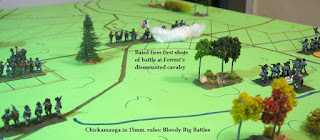Last session we left things hanging. Armstrong’s shot-up dismounted cavalry had suddenly caught fire and
pulverized the Union left flank. There were four turns left in the game. Both
sides had just had lots of cavalry arrive on the field late in the day. Would
we, the Confederates be able to convert this surprise into a game-winner? Ken was
unable to show. We hope he is feeling better. Rick was otherwise engaged. Jay
commanded his Union troops as before, aided by Andrew, a newcomer to
miniatures. I led the Confederate left,
trying to tie down Union reinforcements so the right flank could break through.
I did keep all save the Union cavalry from getting to that flank. That was my
plan. Warning: We ran out of mounted Confederate
figures and had to press 1870 French Chasseurs into service. All Confederate leaders and units are in
italics.
Martin’s cavalry
hit Baird’s Union troops in flank. With a middling die roll, they shoved the
Yankees back.
I showed that I could roll lousy assault dice too.
Back on the Confederate
right.
And our dice kept sucking.
Back on my flank:
And here our troubles began.
And then one decent die roll.
We played 4 turns in 3 hours. The final result was a
sanguinary tie. In total, the game lasted 7 hours. It would have gone faster if
we had 2 experienced players per side but the weather and such didn’t
cooperate.
Confederate losses
were 15 infantry, with 5 ran away and 9 cavalry with 1 ran away, heavier losses
than Bragg managed in the actual
fight. Union losses were 12 infantry with 3 runaways, 3 cavalry with 1 runaway,
and 1 artillery battalion. This was slightly less than the actual Union losses.
All agreed it was a crackerjack game and can certainly bear replay. But next
time, a couple weeks hence we will see how young General Bonaparte does along
the Italian Riviera.
Both Forrest and
Longstreet were hit. Our house rules determined that Forrest was seriously wounded but was back in service after a week.
Longstreet’s wound wasn’t as severe; he was out of action for 4 days.
Postscript: after sleeping on it, I am amazed that we had a few actual saber charges in the woods. The sudden collapse of the Union left just as both sides got substantial cavalry reinforcements led to this most unusual spectacle. Our cavalry most often rides to the front and dismounts.
Happy New Year to all!
Postscript: after sleeping on it, I am amazed that we had a few actual saber charges in the woods. The sudden collapse of the Union left just as both sides got substantial cavalry reinforcements led to this most unusual spectacle. Our cavalry most often rides to the front and dismounts.
Happy New Year to all!




















































